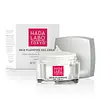What's inside
What's inside
 Key Ingredients
Key Ingredients

 Benefits
Benefits

 Concerns
Concerns

 Ingredients Side-by-side
Ingredients Side-by-side

Water
Skin ConditioningHydroxyethyl Urea
HumectantButylene Glycol
HumectantGlycerin
HumectantPentylene Glycol
Skin ConditioningPEG/PPG/Polybutylene Glycol-8/5/3 Glycerin
HumectantSqualane
EmollientTriethylhexanoin
MaskingAmmonium Acryloyldimethyltaurate/Vp Copolymer
Agar
MaskingAlpha-Glucan
HumectantArginine
MaskingCitric Acid
BufferingDimethicone
EmollientDipropylene Glycol
HumectantDisodium EDTA
Glucosyl Ceramide
Skin ConditioningHydrolyzed Collagen
EmollientHydrolyzed Hyaluronic Acid
HumectantIodopropynyl Butylcarbamate
PreservativeMethylisothiazolinone
PreservativeSodium Acetylated Hyaluronate
HumectantSodium Chloride
MaskingSodium Citrate
BufferingSodium Hyaluronate
HumectantTriethyl Citrate
MaskingWater, Hydroxyethyl Urea, Butylene Glycol, Glycerin, Pentylene Glycol, PEG/PPG/Polybutylene Glycol-8/5/3 Glycerin, Squalane, Triethylhexanoin, Ammonium Acryloyldimethyltaurate/Vp Copolymer, Agar, Alpha-Glucan, Arginine, Citric Acid, Dimethicone, Dipropylene Glycol, Disodium EDTA, Glucosyl Ceramide, Hydrolyzed Collagen, Hydrolyzed Hyaluronic Acid, Iodopropynyl Butylcarbamate, Methylisothiazolinone, Sodium Acetylated Hyaluronate, Sodium Chloride, Sodium Citrate, Sodium Hyaluronate, Triethyl Citrate
Water
Skin ConditioningButylene Glycol
HumectantArbutin
AntioxidantNiacinamide
SmoothingPEG-240/Hdi Copolymer Bis-Decyltetradeceth-20 Ether
StabilisingGlycerin
HumectantGlycosyl Trehalose
Emulsion StabilisingHexylglycerin
HumectantPhenoxyethanol
PreservativeDisodium Succinate
MaskingSodium Metabisulfite
AntioxidantDextrin
AbsorbentArginine
MaskingSuccinic Acid
BufferingHydroxypropyltrimonium Hyaluronate
Citrus Junos Seed Extract
AntioxidantHydrolyzed Hyaluronic Acid
HumectantPotassium Laurate
EmulsifyingTocopherol
AntioxidantMethylparaben
PreservativeSodium Hyaluronate
HumectantSodium Acetylated Hyaluronate
HumectantWater, Butylene Glycol, Arbutin, Niacinamide, PEG-240/Hdi Copolymer Bis-Decyltetradeceth-20 Ether, Glycerin, Glycosyl Trehalose, Hexylglycerin, Phenoxyethanol, Disodium Succinate, Sodium Metabisulfite, Dextrin, Arginine, Succinic Acid, Hydroxypropyltrimonium Hyaluronate, Citrus Junos Seed Extract, Hydrolyzed Hyaluronic Acid, Potassium Laurate, Tocopherol, Methylparaben, Sodium Hyaluronate, Sodium Acetylated Hyaluronate
 Reviews
Reviews

Ingredients Explained
These ingredients are found in both products.
Ingredients higher up in an ingredient list are typically present in a larger amount.
Arginine is an amino acid that is important for human development. Your body uses is it to produce hair keratin and skin collagen.
As a cosmetic ingredient, Arginine has antioxidant properties and can also help repair damaged skin. This ingredient is derived either synthetically or from animals.
Arginine isn't fungal acne safe when used in the presence of other lipids (fats, fatty acids, oils, esters, etc). Oils and fats occur naturally within the skin, so take caution when using Arginine if you're prone to fungal acne.
Learn more about ArginineButylene Glycol (or BG) is used within cosmetic products for a few different reasons:
Overall, Butylene Glycol is a safe and well-rounded ingredient that works well with other ingredients.
Though this ingredient works well with most skin types, some people with sensitive skin may experience a reaction such as allergic rashes, closed comedones, or itchiness.
Learn more about Butylene GlycolGlycerin is already naturally found in your skin. It helps moisturize and protect your skin.
A study from 2016 found glycerin to be more effective as a humectant than AHAs and hyaluronic acid.
As a humectant, it helps the skin stay hydrated by pulling moisture to your skin. The low molecular weight of glycerin allows it to pull moisture into the deeper layers of your skin.
Hydrated skin improves your skin barrier; Your skin barrier helps protect against irritants and bacteria.
Glycerin has also been found to have antimicrobial and antiviral properties. Due to these properties, glycerin is often used in wound and burn treatments.
In cosmetics, glycerin is usually derived from plants such as soybean or palm. However, it can also be sourced from animals, such as tallow or animal fat.
This ingredient is organic, colorless, odorless, and non-toxic.
Glycerin is the name for this ingredient in American English. British English uses Glycerol/Glycerine.
Learn more about GlycerinHydrolyzed Hyaluronic Acid is a form of hyaluronic acid. It is created by the hydrolysis of hyaluronic acid with a high molecular weight. Once created, Hydrolyzed Hyaluronic Acid has a low molecular weight.
Low molecular weight HA has been shown to hydrate and increase elasticity of the skin. Increasing elasticity is also associated with reduction of wrinkle depth.
One study found topical low molecular weight hyaluronic acid may be considered for the treatment of rosacea in the adult population. However, we always recommend speaking with a professional about your skin concerns.
Hyaluronic acids are a humectant. This means they draw moisture from the air. Hyaluronic acids help moisturize, soothe, and protect the skin.
Read more about other common forms of hyaluronic acid:
Learn more about Hydrolyzed Hyaluronic AcidSodium Acetylated Hyaluronate is a type of Hyaluronic Acid.
Hyaluronic Acids help moisturize, soothe, and protect the skin.
Read about common types of Hyaluronic Acid here:
Sodium Hyaluronate
Hydrolyzed Hyaluronic Acid
Hyaluronic Acid
Sodium Hyaluronate is hyaluronic acid's salt form. It is commonly derived from the sodium salt of hyaluronic acid.
Like hyaluronic acid, it is great at holding water and acts as a humectant. This makes it a great skin hydrating ingredient.
Sodium Hyaluronate is naturally occurring in our bodies and is mostly found in eye fluid and joints.
These are some other common types of Hyaluronic Acid:
Learn more about Sodium HyaluronateWater. It's the most common cosmetic ingredient of all. You'll usually see it at the top of ingredient lists, meaning that it makes up the largest part of the product.
So why is it so popular? Water most often acts as a solvent - this means that it helps dissolve other ingredients into the formulation.
You'll also recognize water as that liquid we all need to stay alive. If you see this, drink a glass of water. Stay hydrated!
Learn more about Water